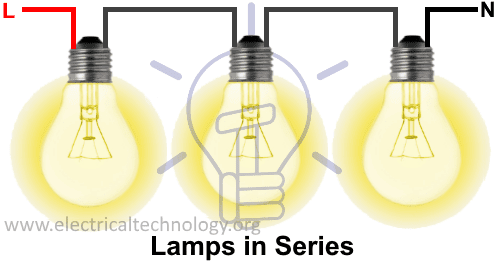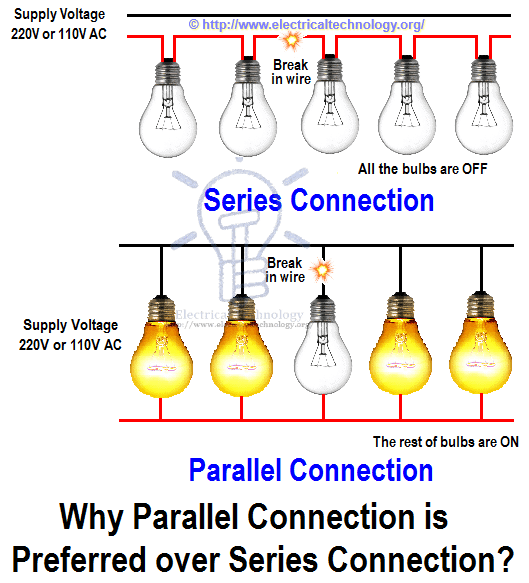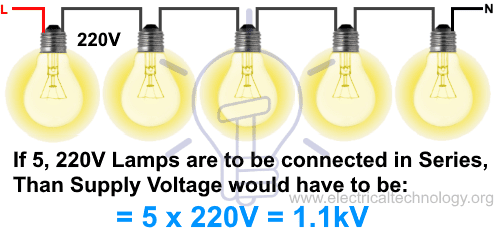How to Connect Lights Points in Series?
In today basic electrical wiring installation tutorial, we will show how to wire lighting points in sires?. Although, we know that series connection for household wiring like fans, switches, light bulbs etc is not a preferred way instead of parallel or series-parallel wiring. But in some case, we need to wire and connect electrical appliances in series as well.

In above fig, all the three light points are connected in series. Each lamp is connected to the next one i.e. the L (Line also known as live or phase) is connected to the first lamp and other lamps are connected through middle wire and the last one wire as N (Neutral) connected to the supply voltage then.
according to the series circuit analogy, the flowing current is same in all these incandescent bulbs / lamps but the voltage are different as opposed to the parallel circuit where voltage are same at each point where current are different.
One of the major disadvantage of series lighting circuit, adding or removing one lamp from the circuit will affect the over all circuit i.e. others lamps will dim in light and other connected devices and appliances will not get the sufficient or required operated voltage because the voltage in series circuit is different at each point but the flowing current is same.
Any number of lighting points or load can be added (according to the circuit or sub-circuit load calculation) in this kind of circuit by simply extending the L and N conductors to other lamps but they will not glowing according to the rated output efficiency. in short, adding more light bulbs in series circuit will dim the rest of the light points.
another major defect of series lighting circuit is that as all lamps or bulbs are connected between Line L and Neutral N accordingly, if one of the light bulb gets faulty, the rest of the circuit will not work as the circuit will be open as shown in fig below. Here, you can see there is a cut in the line wire connected to lamp 3, so the bulb is switch OFF and the rest circuit is working properly i.e. bulbs are glowing.

Disadvantages of Series Lighting Circuit.
- The break in the wire, failure or removal of any single lamp will break the circuit and cause all of the others to stop working as there is only one single path of current to flow in the circuit.
- If more lamps are added in series lighting circuit, they will all be reduced in brightness. because voltage are shared in series circuit. If we add more loads in series circuit, the over voltage drop is increases which is not a good sign for electrical appliances protection.
- Series Wiring is “ALL or NONE” type wiring mean all the appliances will work at once or all of them will disconnect if fault occurs at any one of the connected device in series circuit.
- High supply voltage are needed if we need to add more load (light bulbs, electric heaters, air conditioner etc) in the series circuit. For example, If five, 220V Lamps are to be connected in Series, Than Supply Voltage would have to be: 5 x 220V = 1.1kV.
- The overall series circuit resistance increases (and current decreases) when more load added in the circuit.
- According to future need, only those electrical appliances should be added in the current series circuit if they has the same current rating as current are same at each point in series circuit. However, we know that electrical appliances and devices i.e. light bulbs, fan, heater, air conditioner etc have different current rating, therefore, they can not be connected in series circuit for smooth and efficient operation.

Advantages:
- Less size of wire cable is required in series wiring.
- We use to protect the circuit to connect fuse & circuit breakers in series with other appliances.
- Series circuit don’t get overhead easily due to high resistance when more load added in the circuit.
- The lifespan of battery in series circuit is more as compared to parallel.
- It is most simple method of electrical wiring and fault can be easily detect and repair as compared to parallel or series-parallel wiring.

No comments:
Post a Comment